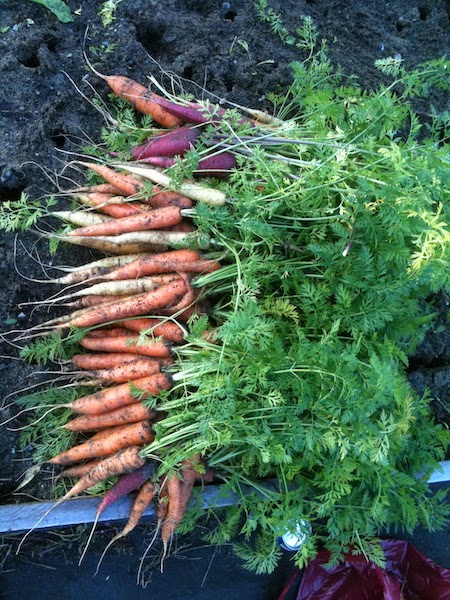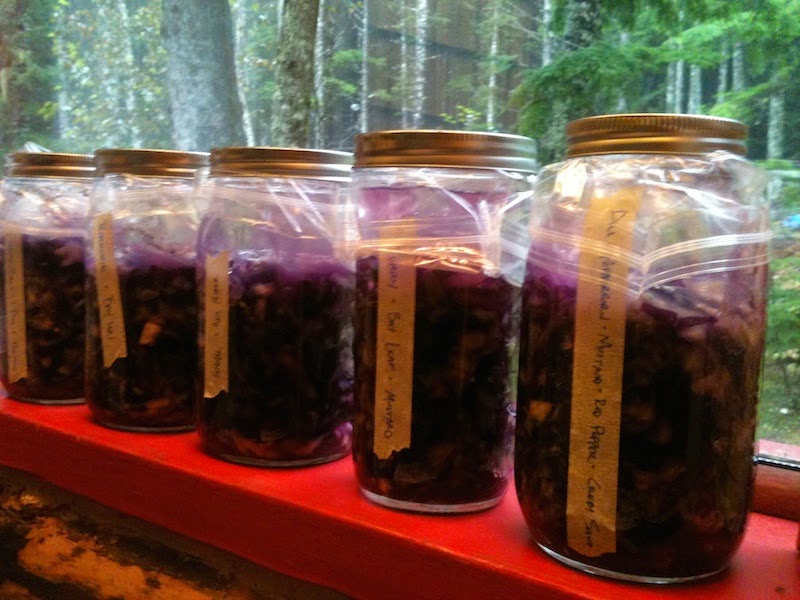by Katie Craney, an Alaska Master Gardener

All of the hard work has paid off, its harvest time! I’ve found that I enjoy planting my garden just as much as figuring out ways to keep the freshness and flavors of summer and fall going through the winter. As a gardener and forager, I spend so much time planning and waiting for the right time to pick that I feel I owe it to myself to get the most out of every effort! It can feel a little overwhelming during harvest, especially with our short summer season and when trying to beat the first frost. The last thing you want is your hard earned fruits, veggies, and wild foods to go to waste. Here are some of my favorite preservation techniques for wild and cultivated foods.
Syrups, Jams, Jellies, and Sauces
 As an alternative to maple syrup, which I grew up with, I’ve adapted to piney spruce tip syrup and have been making my own every year since I moved to Southeast Alaska. Pick the young emerging tips in the spring before they explode. The tips are high in vitamin C and with a little sugar, water, and some boiling they make a fantastic, flavorful syrup that can be added as a sweetener in many recipes. We also make rosehip ketchup, rhubarb salsa, highbush cranberry juice and syrup, blueberry jam, black current jam, raspberry jam, nagoonberry jam, wild strawberry jam, and cherry jelly. All of these are cooked and canned following the canning methods available from the Cooperative Extension Service website listed below and can be stored in the pantry for about a year, if we let them last that long.
As an alternative to maple syrup, which I grew up with, I’ve adapted to piney spruce tip syrup and have been making my own every year since I moved to Southeast Alaska. Pick the young emerging tips in the spring before they explode. The tips are high in vitamin C and with a little sugar, water, and some boiling they make a fantastic, flavorful syrup that can be added as a sweetener in many recipes. We also make rosehip ketchup, rhubarb salsa, highbush cranberry juice and syrup, blueberry jam, black current jam, raspberry jam, nagoonberry jam, wild strawberry jam, and cherry jelly. All of these are cooked and canned following the canning methods available from the Cooperative Extension Service website listed below and can be stored in the pantry for about a year, if we let them last that long.
Cold Storage:
This was the first year I’ve had an abundance of apples. With the bruised apples we made two batches of apple butter, a batch of applesauce, and preserved pie apple slices. I have a couple of boxes in the basement of the best apples that will last at least a couple of months as long as they are stored properly. Apples are stored in a cardboard box and a layered with newspaper and shredded cardboard as a way to keep them from crushing each other. Make sure to store only the best looking apples, avoid bruises or blemishes and they can start to mold and rot. If you do not have a basement, any area that is just above freezing could work, like an arctic entry, garage, pantry, or if your lucky, a root cellar! Carrots, beets, potatoes, onions, and cabbages, rutabagas, turnips, and parsnips can all be stored in similar ways.
Fermenting and Pickling
 With an over abundance of cabbage I decided it was time to try making sauerkraut. We have six quart’s fermenting in mason jars right now; each quart has a different spice mixture. The fermenting process takes a little longer in our cabin due to keeping it at a lower temperature so the kraut might be ready in two or three weeks. Nearly all vegetables can be fermented in this way. Next year we plan to try fermented kale and carrots. We made a few types of pickles this year including sweet beets, dilly peas, dilly carrots, and bull kelp pickles. All store well if properly prepared following the home canning directions provided in the links below.
With an over abundance of cabbage I decided it was time to try making sauerkraut. We have six quart’s fermenting in mason jars right now; each quart has a different spice mixture. The fermenting process takes a little longer in our cabin due to keeping it at a lower temperature so the kraut might be ready in two or three weeks. Nearly all vegetables can be fermented in this way. Next year we plan to try fermented kale and carrots. We made a few types of pickles this year including sweet beets, dilly peas, dilly carrots, and bull kelp pickles. All store well if properly prepared following the home canning directions provided in the links below.
In the Freezer
In our freezer we have several bags of chopped herbs, chopped rhubarb, wild berries, and prepared kale. One of my favorite techniques for easily accessible frozen kale seems genius: Remove stems and chop kale into 1 inch pieces of less. Place the chopped kale in boiling water for about 30 seconds to a minute, just enough to see the color change to a bright green. Remove kale to an ice bath with a slated spoon. Kale can be dried for a few minutes on a kitchen cloth or directly placed in an ice cube tray. Fill the tray by pressing kale down firmly into the cubes. If there is a lot of water, drain the tray gently. Place the filled tray in the freezer for a few hours. When the kale has froze, remove the kale cubes and place in a freezer bag. The cubes are convenient to use for smoothies, soups, and main dishes without the hassle of having to thaw an entire bag of frozen kale.
Resources
There are many resources available on home food preservation and canning. Here are some that I continue to refer back to:
Preserving Alaska’s Bounty: news.uaf.edu/extension-releases-food-preservation-dvds/
National Center for Home Food Preservation – Complete Guide to Home Canning: https://nchfp.uga.edu/publications/publications_usda.html
UAF Cooperative Extension Food Preservation:
https://www.uaf.edu/ces/foods/preservation
About Heidi Rader
Twitter •
